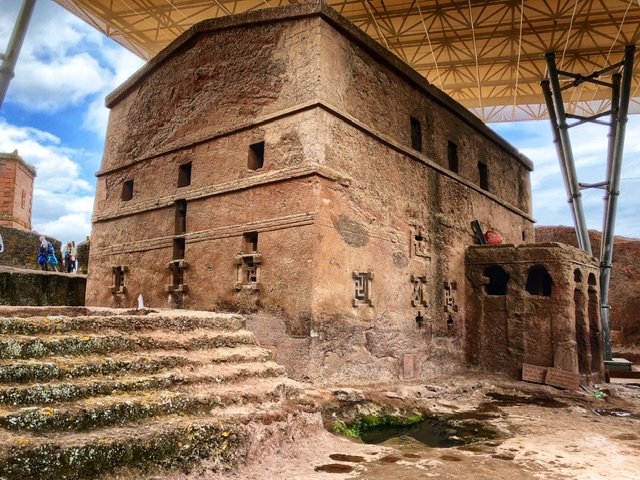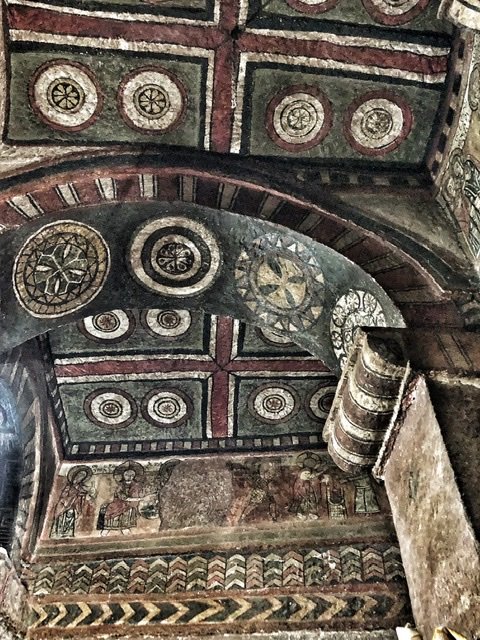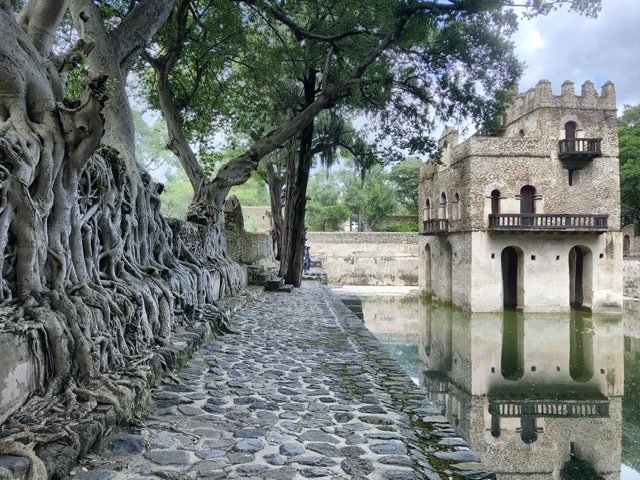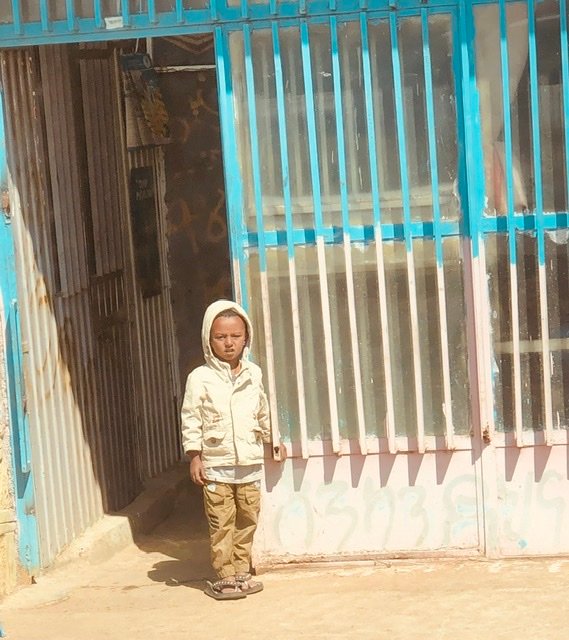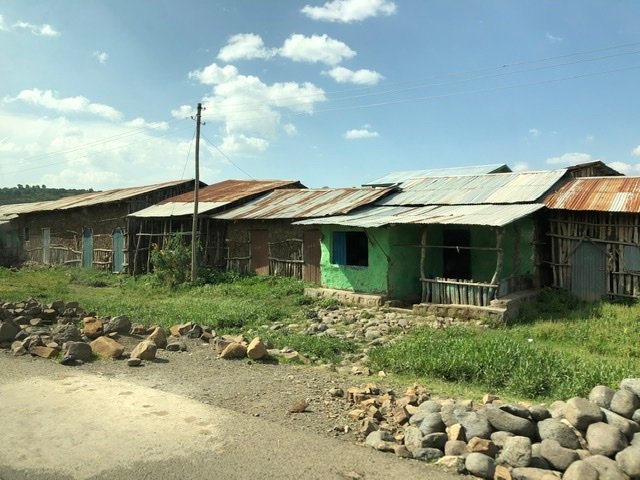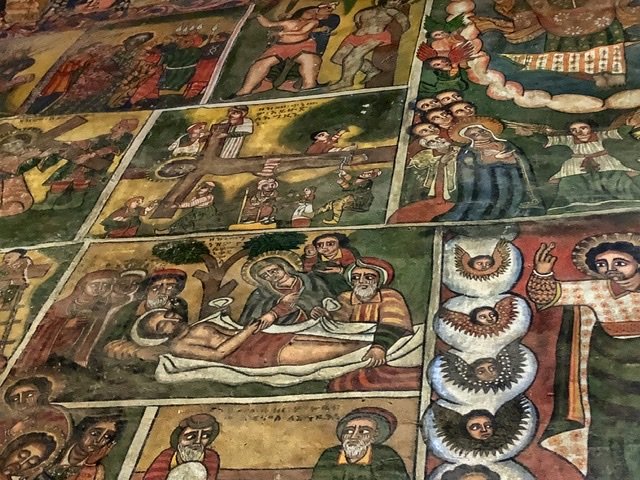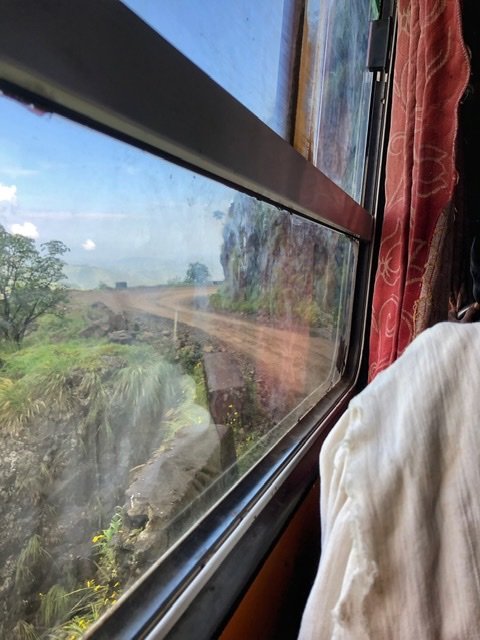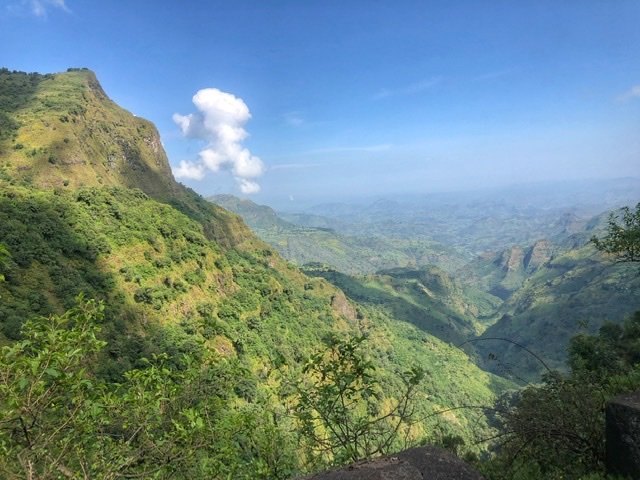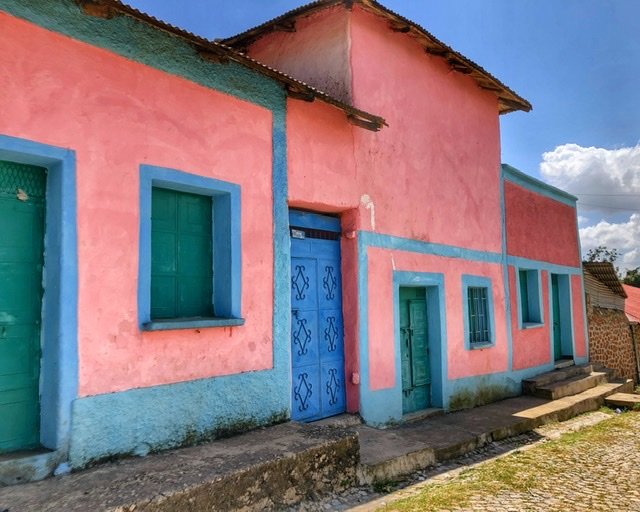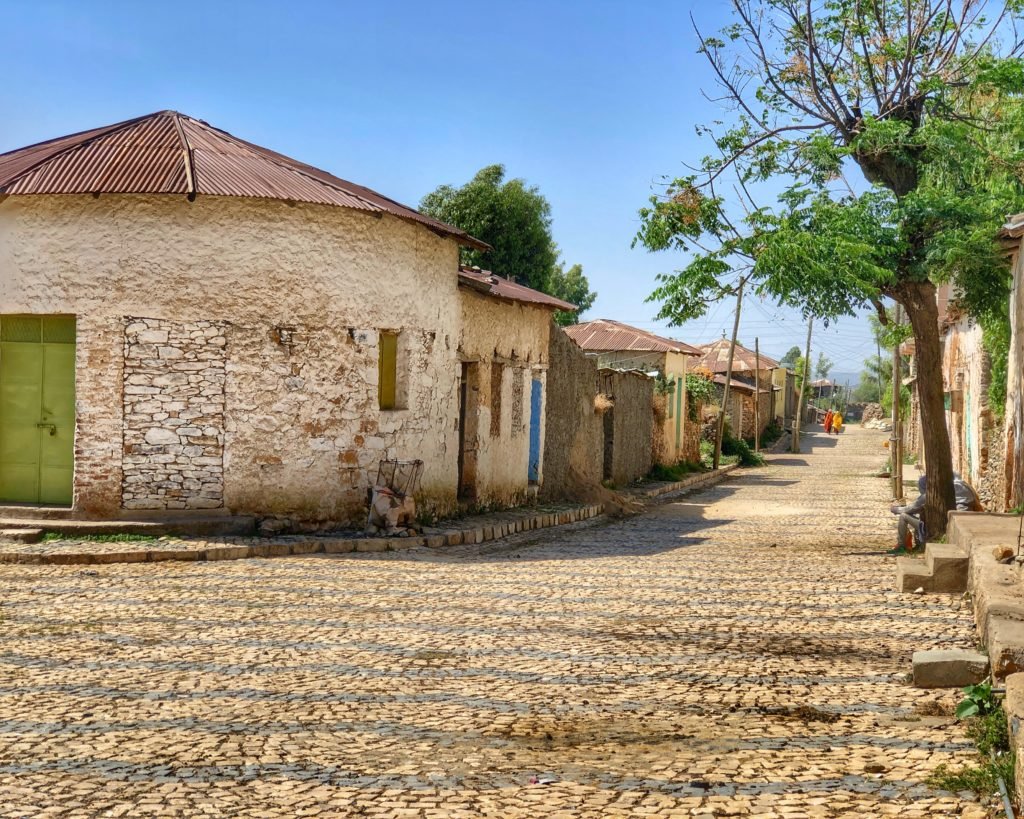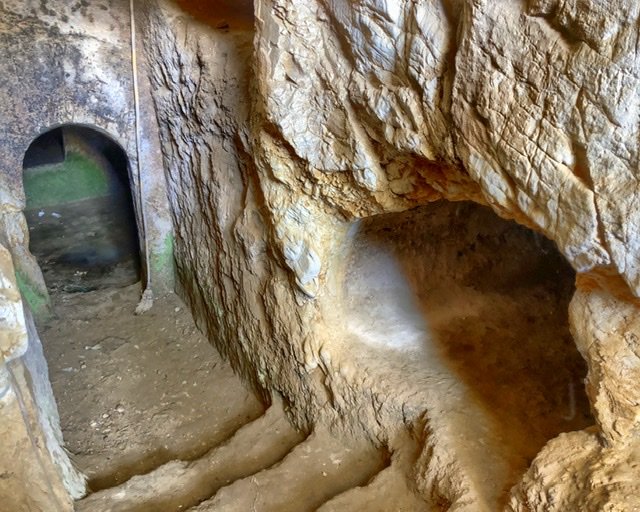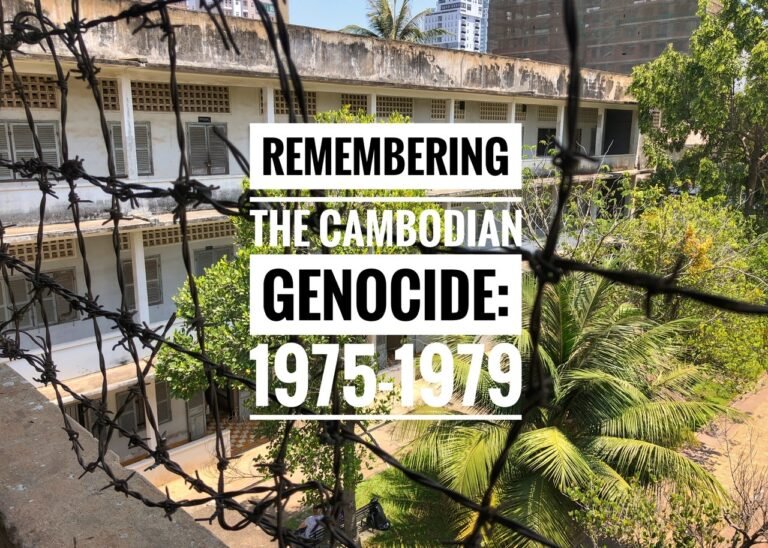
Flux capacitor set. Time circuits on. It was time to Marty McFly our way back to September 21, 2012. After weeks in the brown Tanzanian plains and bush, we were beyond enthralled to be greeted by nothing but shades of green as we touched down in Lalibela, Ethiopia where we immediately gained 7 years, 9 months and 10 days. Confused?! We were too. You see, the Ethiopian and Gregorian (western) calendars both use the birthdate of Jesus Christ as a starting point for their calculations. The difference in the two calendars is because alternate calculations are used in determining what that date actually is. Add to this, they also have an extra month, and a different time clock. Whew…this country is head-scratchingly fascinating already.

There are a lot of stereotypes about Africa. One of them is that everywhere is either desert, bush or jungle. But in fact, flying in, you can see it was far from that.
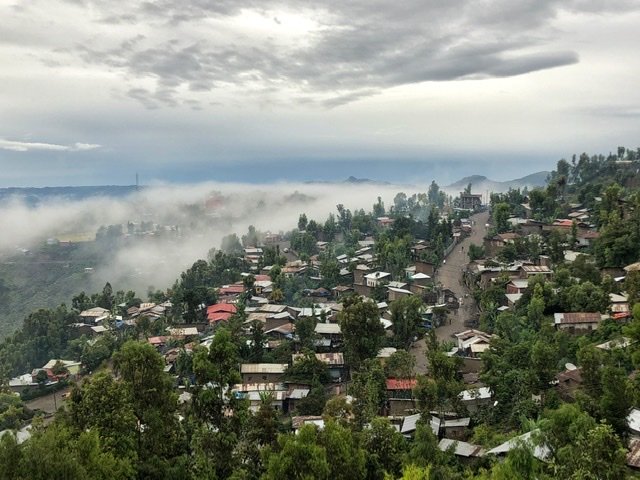
This picture is of the view from our hotel window (Blue Nile, $25/night) in Lalibela.
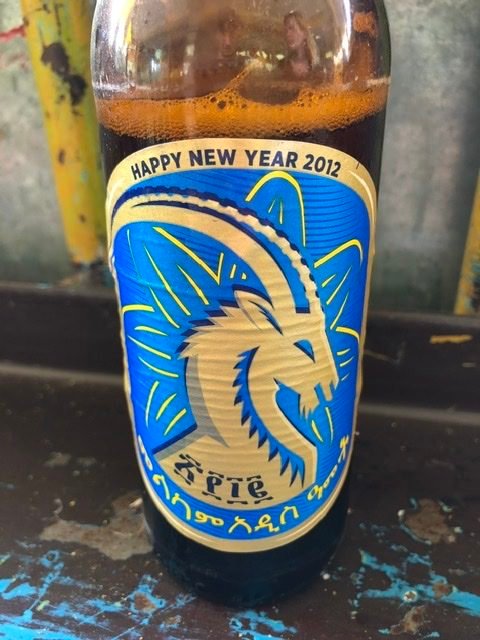
Happy New Year!! That’s right. 2012. The Ethiopian Orthodox Church believes Jesus Christ was born in 7 BC, 5,500 years after God’s promise to Adam and Eve. And because Ethiopia was the only African country not colonized by Europe, it was able to maintain its own image of what Christianity entails. This is also reflected in the Ethiopian time. To them, their day begins at our western 6 am when the sunrises and ends at 6 pm when the sunsets. So this is also when their clock starts. 6 am=12, 7 am=1, 8 am=2, and so forth. It then resets at 6 pm back to 12. Initially, it’s extremely puzzling, but when you think about it, it totally makes sense. However, this undeniably only works in a country bordering the equator without significant changes in sunrise and sunset. Ah, minor details…
While there, it occurred to Mandy that the US should be selling all their leftover New Year’s Eve party paraphernalia at super discount cost to Ethiopia. Would certainly be a better use of the crappy Chinese party horns and hats, and they’ll obviously need it….albeit in seven years.

We made Lalibela our first stop in Ethiopia to see the UNESCO world renowned rock-hewn churches, but first we had a day to just get our bearings…or rather adapt. Unlike most places we’ve visited, going for a nice stroll in Lalibela is not really something you can easily do. As Farangis (foreigners), you will instantly be accompanied by one to ten opportunistic street kids, and often adults, all asking identical questions…
- How are you?
- Where you from?
- Where do you go?
- First time in Lalibela?
- Do you need a tour?
On that first walk for us, we picked up four high schoolers. The best (truly stellar!) English speaker held the conversation and told us his plans to become a dentist, how there were no dentists in Lalibela, and how everyone had rotting teeth and only used eucalyptus tree branches to brush their teeth. He seemed like a good kid (or a phenomenal schemer) and eventually we naively gave him 60 Birr (about $2) to use to put toward a book he needed for school. (For the record, monthly rent is $40 in Lalibela so $2 is a nice chunk of change.) His response, instead of thanking us, was complaining that we’d only given him 60 and he needed 100.
It was then we realized how difficult this was going to be. Nearly every single person wanted something from you. A pen, candy, tours or money. As a faranji, you are disappointingly treated as a walking ATM. In fact, some (adorable) kids as young as three just approach you with outstretched hands saying, “money.”
Unfortunately this is because many a tourist before us have just been blindingly opening their purses to everyone without going through the proper channels. It’s the worst in Lalibela as a major tourist destination. We gave money where we felt it was warranted, but in the end vowed to let our community treks and hefty service tips be our charitable donation to the country’s people. Needless to say, the culture shock of this got very overwhelming the first few days.

Case in point. One little malevolent hoodlum photo bombing our picture.

That said, perhaps it’s no surprise that we darted into a restaurant almost immediately to find solace in the mouthwatering Ethiopian cuisine. We have eaten Ethiopian food, a lot, in Portland. In fact, it’s one of our favorites and was one driving force to our visit to the country. But truly, nothing beats the dishes we’ve had here.
Our first meal at the “Unique Restaurant” was pretty basic, despite its name, but had a friendly cook, and our meal consisted of “fasting food”—spinach, lentils, beetroot, and cabbage, as well as tibs, freshly flash-fried lightly spiced meat mixed with onions and peppers. This is all served over the national staple of injera, the spongy semi-fermented pancake-like bread which is eaten with your (right) hand. Mastering the one hand technique is a bit challenging, however. You also have to get used to the fact that many places don’t have napkins and it’s impolite to lick your fingers so you’re usually sitting around with a toddler-esque right paw until the server brings the water around to drizzle over your hands. This meal set us back $6.50 for two entrees and two beers, which we realized was actually pricy after being in Ethiopia awhile.

It was the next day we found our jackpot restaurant which we returned to twice, Segenet Cafe & Restaurant. The quality was superb and the ladies that ran it were absolute sweethearts with huge smiles. We had the injera with vegetables and what turned into our favorite dish, Shero Tegamino (not pictured) which is a spicy bean and chickpea thick purée served with injera. 30 Ethiopian Birr is equivalent to $1 so you can see how ridiculously inexpensive it is by the menu.
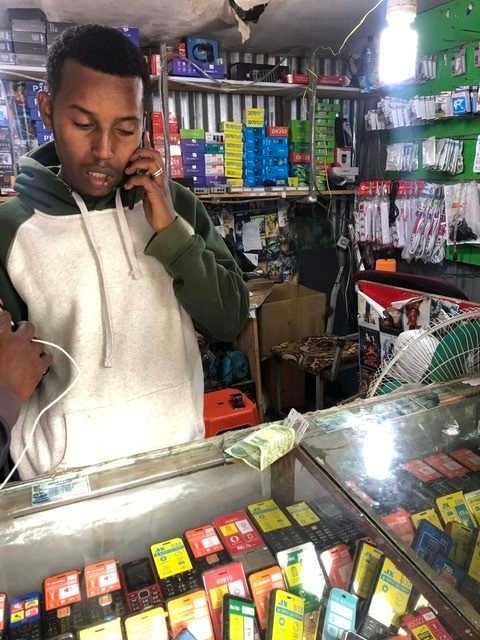
It was then off to try to get a SIM card to make our phone work, as Ethiopia is one country our Google Fi plan lacks.
- First we had to find the Ethiotel “office” which was hidden behind a wall of mud with a tin door.
- Greg then had a very disjointed conversation with the Ethiotel service lady trying to tell her we wanted to buy “pay as you go” credit and not the unlimited 800 birr ($27) clearly Faranji-only package.
- After she had registered the SIM to our passport and we paid 30 Birr (only $1), the lady gave us a SIM card that was entirely too big for our phone. When we tried to explain it was too big, she just shrugged, her face seeming to respond “not my mother-f’ing problem.”
- After asking for our money back, she conversed with her colleague who loosely explained to us we had to go somewhere else to get our SIM card cut down.
- Thanks to our hotel reception, we put the pieces together that we had to visit the “mobile store” (which they had to hand deliver us to because nothing looks like what it is) Here, they actually cut our SIM card using a sophisticated SIM card punching instrument and got our phone working.?
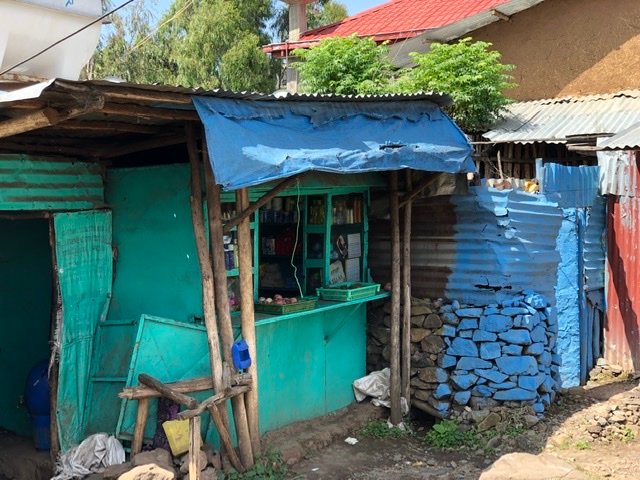
You can see why we had troubles finding the store! This is what an average business looks like in Lalibela, a unsigned mini market. We also went into a pharmacy looking for some hand sanitizer. The pharmacist pulled it out without hesitation from a glass bin that looked like something out of Hoarders. It was crazy to see the disorganization and chaos of something as significant as a pharmacy.

While their schoolmates were stalking feranjis, these boys were just being boys playing foosball or table tennis in the streets.
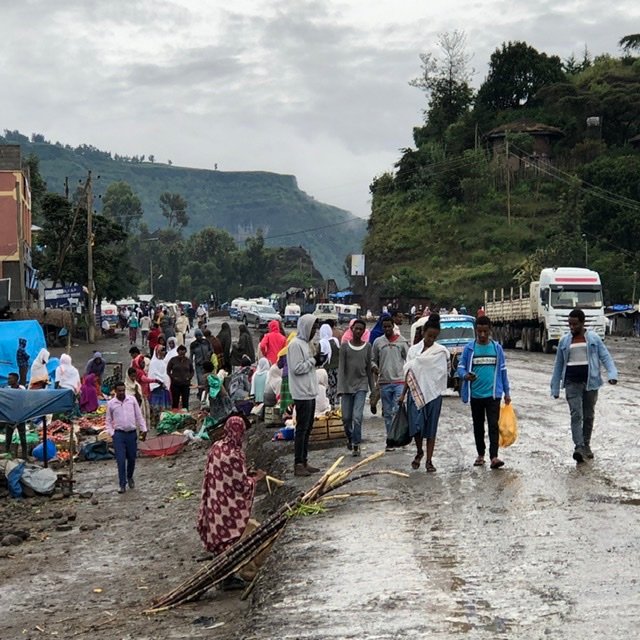
A typical street scene in Lalibela. There was a LOT of rain while we were there so we were able to witness the state of mud and flooding the streets are overloaded with after such rains.

Although we got off to a rough start, we managed to meet some very special people in Lalibela who made it all worth it. Bottom left is Aregahgn, who was our guide on our trek (pics coming soon) who graciously invited us to his house for dinner to meet his wife and daughter. We even had a cooking lesson! (Shero Tegamino, top right?) Many people don’t have full kitchens/stoves so we cooked in a teeny charcoal stove in his living room.
Secondly, we met two great guys on our shuttle ride from the airport…Rohma and Abel. They were in Lalibela on business and were so genuine! We didn’t plan to hang out with them again but they walked into the Tej bar we were in one evening so we got to have a drink together!
P.s. what’s Tej?! Tej is a delightful honey wine brewed exclusively in Ethiopia and Eritrea.
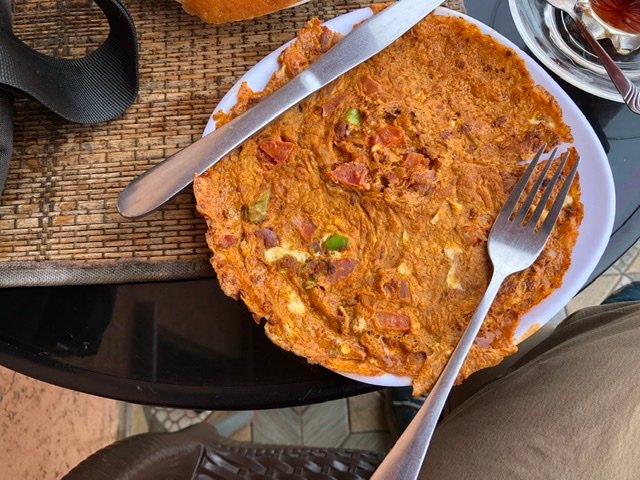
Other not-as-amazing things we ate regularly included Ethiopian omelets which were spiced with flavors including chili, turmeric, and cinnamon.

Also, the potato chips of Ethiopia. A roasted barley blend with some spices. Certainly healthier, and tastes like it.

Rock-Hewn Churches of Lalibela
And now for the reason we came to Lalibela… the surreal and mystical subterranean rock-hewn churches hand-carved in the 11th to 13th Centuries. Sometimes cited as one of the unofficial eighth wonders of the world, and UNESCO World Heritage Site, visiting the Lalibela churches is the number one tourist attraction in Ethiopia. And, they are absolutely remarkable! They are unlike any other place we’ve been except maybe Petra in Jordan. The entrance tickets to the churches is very steep and a huge splurge, at $50 per person, but they are valid for five days which can make it more worthwhile if you can spread your visit out over multiple days. Most people also grab a guide to help them navigate the 11 churches and underground network of tunnels and passageways, for about $20, but if you do make sure they are an official guide, picked up at the church entrance office. If you elect to go sans guide, you can easily visit the churches on your own, as we did.
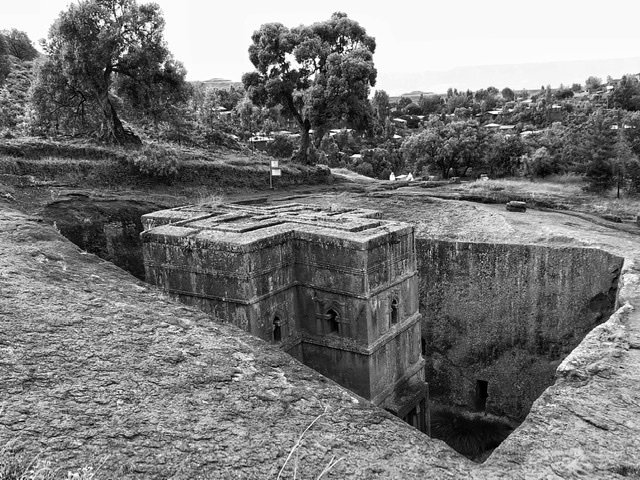
The church of St. George is the most impressive, and breathtaking of all the 11 rock churches at Lalibela. And rightfully so. It’s commonly referred to as the showstopper and pinnacle of engineering for the site.

St. George is carved to a depth of 15 meters and in the shape of a symmetrical cruciform tower. The churches of Lalibela were hand carved out of soft tufa lava rock between the 11th and 13th centuries. King Lalibela directed the construction after Muslim conquests halted Christian pilgrimages to the holy Land. It is said the churches were carved below grade to aid in keeping them secret and hidden from Muslim marauders.
One of the most serene moments was greeting the sunrise over St. George. All we heard were the birds and chanting. Beyond peaceful.
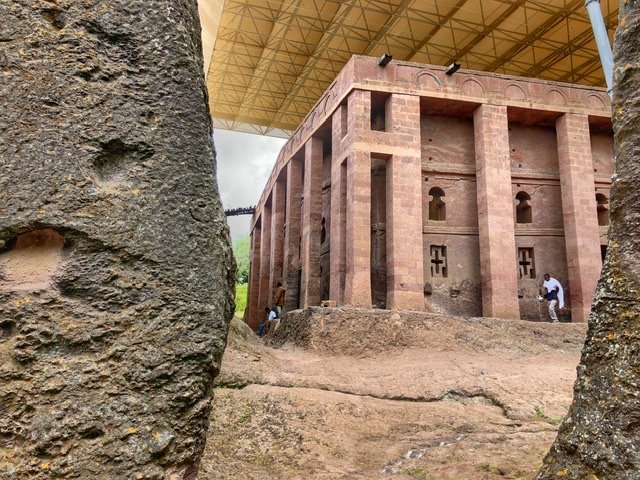
Bet Maryam Church. Some of the churches were incredibly excavated to a depth of more than 30’ (10 meters). King Lalibela directed the creation of the stone churches (including a “Jordan River” carved out of solid rock) to act as a “New Jerusalem” for worshipers who could not make the pilgrimage to Jerusalem. Each church is unique in style and size.
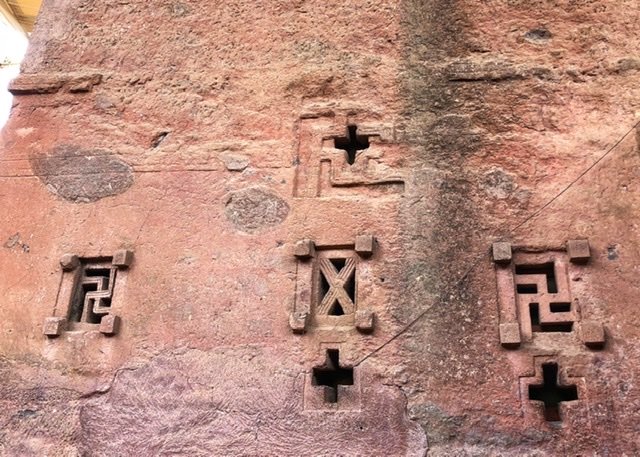
Other original emblems found on the church included a familiar now corrupt symbol, which before Hitler destroyed had very different connotations and still does today for Hinduism, Buddhism and Jainism. It was also used as a stylized cross in Christianity. Regardless of the religious use, from its earliest conception, the symbol is believed to have been positive and encouraging of life.
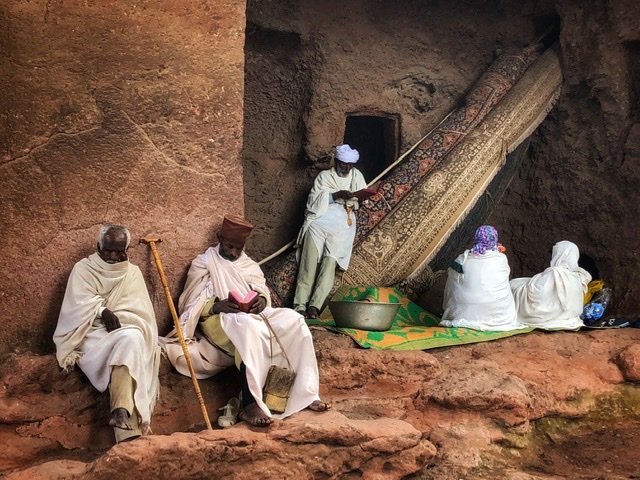
A cluster of white-robed worshippers and priests congregate outside of Bet Maryam.
The simple, yet striking frescoes painted on the interior of Bet Maryam and exterior or House of the Savior of the World Church is supposedly the world’s largest rock-hewn monolith. It is carved of a single rock and supported by 36 pillars on the inside and 36 on the outside. Some experts think it was modeled indirectly on King Solomon’s temple in Jerusalem.
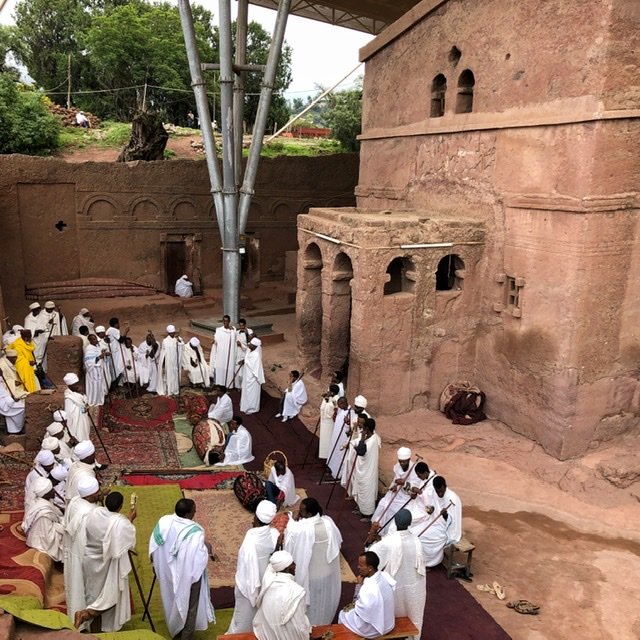
We spread our visit out over three days to have the time to appreciate the grandeur of the site, and on one of the days we were treated to an incredible display of devotion including hours of chanting which began before sunrise and went well into the afternoon.
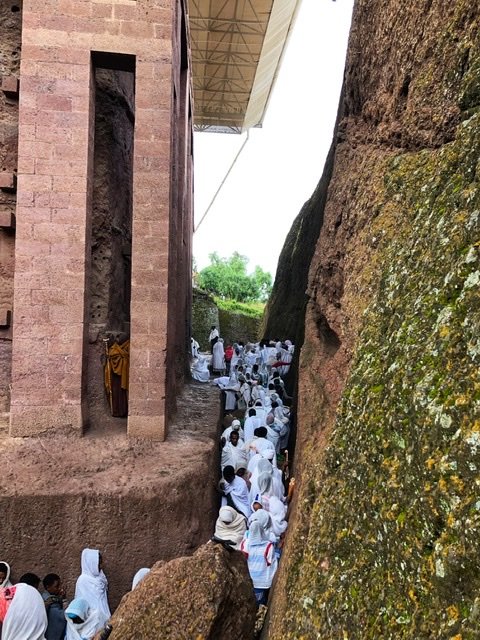
We never got a true explanation for the festivities, other than it had something to do with the ‘true cross’.

Because the churches are still actively used by the Christian Orthodox Church of Ethiopia visiting them usually includes some intense cultural and spiritual immersion as well.
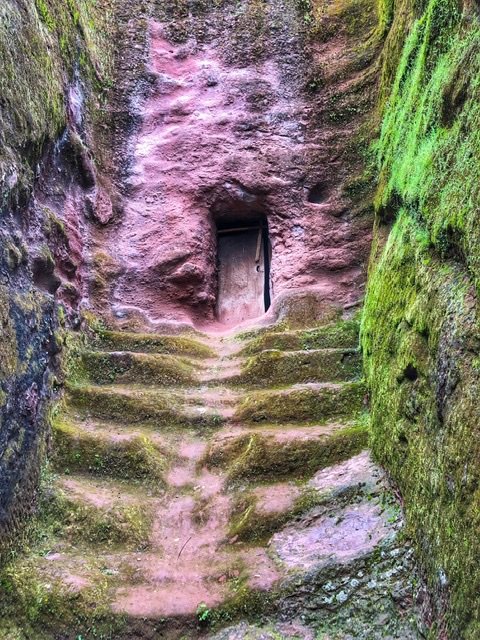
One of entrances to a network of tunnels which connect some of churches.
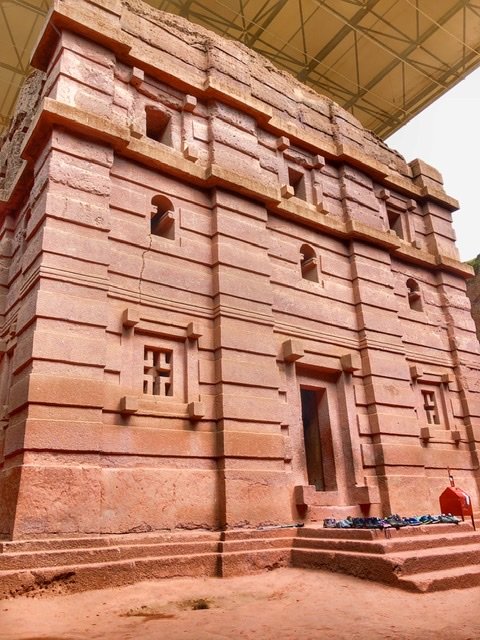
Bet Emanuel church, with its remarkable cleanly cut exterior lines and decorative elements, is regarded to be the finest and most precisely worked church in Lalibela by art historians.
Gondar
From Lalibela, we continued our travels on Ethiopia’s historical circuit by heading west to the city of Gondar, established in 1635. (Gregorian time). This is when we started realizing just how big Ethiopia is…only slightly smaller than two Texases. We sucked it up and paid $40 for a six-hour private transfer rather than $25 for the local bus. This saved us about six additional hours and at least a dozen still un-grey hairs. We were struck by the rock pinnacles that started cropping up in the landscape on our drive.
Gondar is packed with historically significant buildings including a seemingly out of place cluster of fairytale castles, renowned churches, and pleasant tree lined streets. It was a decent place to lay our heads for four nights (Sycamore Pension $15/night).
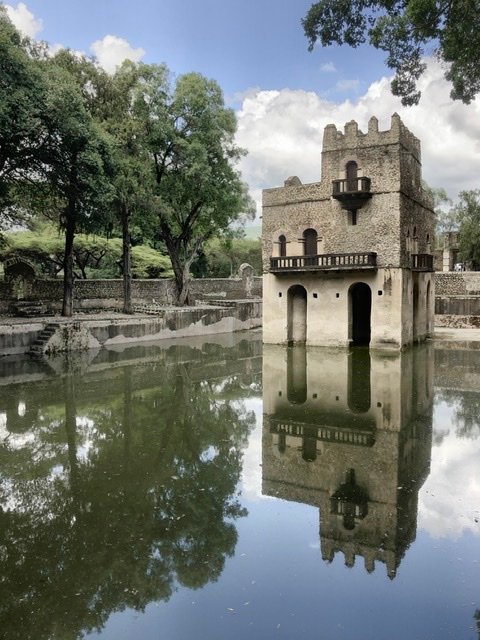
Fasilida’s Pool is about 2k west of the city center, and is included in the price of the Fasil Ghebbi castle complex ($6.75) which is ‘the’ main attraction in Gondar. This striking piece of architecture is a sunken pool and pavilion in the center that is attributed to Emperor Fasilida, the Ethiopian royalty credited to the founding of Gondar in 1636. This is widely said to have been his second residence (and evidently where he parked his inflatable pool toys.)
As mentioned, we struggled a bit in Lalibela when it came to attracting unwanted farenji followers. This walk seemed like the perfect opportunity to try out our newfound hack of keeping touts and opportunistic street kids away. How did we do it?
Well, in Africa walking with purpose always helps. However, as a tourist it’s very difficult to always maintain that purposeful stride. And, when you lapse, acting like a wandering or confused tourist that you are, even for a split second, you’re a sitting duck to be snatched up like candy from a busted piñata.
So, our new hack…we held hands or arms, and maybe acted like we were out for a romantic walk about. That’s it. Apparently, at least in this part of the world, this sends a loud message that we’re having “husband/wife private time” and poof, they mostly left us alone.
Other things we tried before realizing the immense power of husband/wife hand-holding…
- We told someone we were from Moldova to get rid of a particularly clingy guy. Surprisingly He knew about Moldova and actually said our English was pretty good for being from there. Are you f’ing kidding?! Damn world-knowing American accent.
- When someone kids held out hands demanding “candy,” we held out ours and said “yes! Give me candy!”
- One young man attached himself to us saying simply “money?” “Money?” We simply said, “not ATM” and got a half-hearted laugh in return.
- When kids would ask where we’re from, we’d say “guess!” and then string them along with a pop quiz of world geography to buy us walking time to get to…somewhere… sometimes keeping them guessing until we said we’re from Portlandia and they’d look at us completely perplexed.
- We would duck into a shop and usually buy something to ditch someone (which totally defeats the purpose of traveling on a budget.)
- We’d say any of these things, “no time, we’re leaving tomorrow” OR “we already did ____”. (whatever they’re trying to sell you.)
Back to Fasilida’s Bath. Piles and piles of immense tree roots clutch a six-turreted stoned wall surrounding the bath. An absolutely picturesque work of nature art.
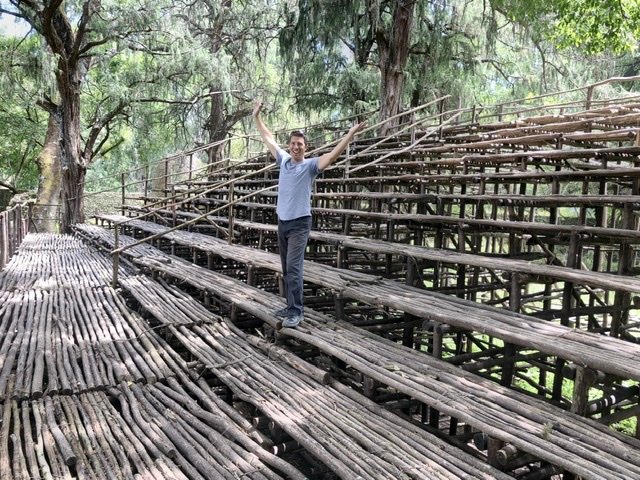
Once a year, this place is the centerpiece for a momentous ceremony where thousands of white-robed worshippers meet around the pool which is filled with river water, and devotees are blessed and sprinkled with the holy pool water by colorful priests. These rather remarkable “bleachers” serve as viewing platforms for the event. At least the sticks they’re strung together with won’t easily conceal any mischievous teenagers (or love-drunk faranjis) beneath them…
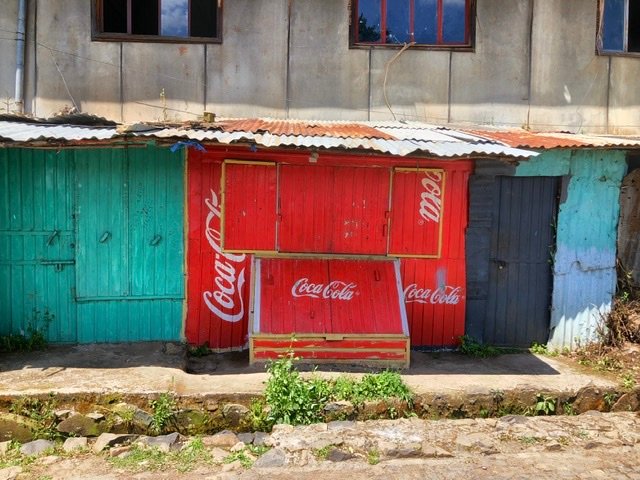
Unlike other places we’ve traveled, in Ethiopia, you are probably not gonna find any Pringle’s (They’re called Mr. Chips here) or Mars Bars (they have Ricco.) In fact, most goods for sale in the shops are made or grown domestically. But, no matter where you go…always Coca Cola. (Cue music?)
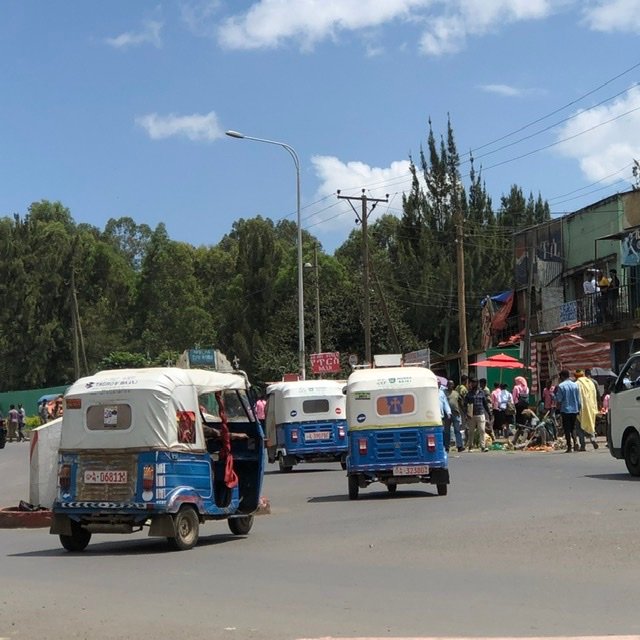
The bajaj, or tuk tuks as they’re more commonly known, are absolutely everywhere in Ethiopia. These and passenger mini vans. There are also trucks. But cars. Where are they? It turns out, Ethiopia has one of the world’s lowest per capita car ownership rates. As of 2018, there were 150,000. To compare, Ethiopia has 110 million people, a population which has quintupled in 75 years. This has led to a high number of young people, often university educated, who cannot find jobs in their fields. But, the economy is on a definite upswing and things are improving drastically overall.
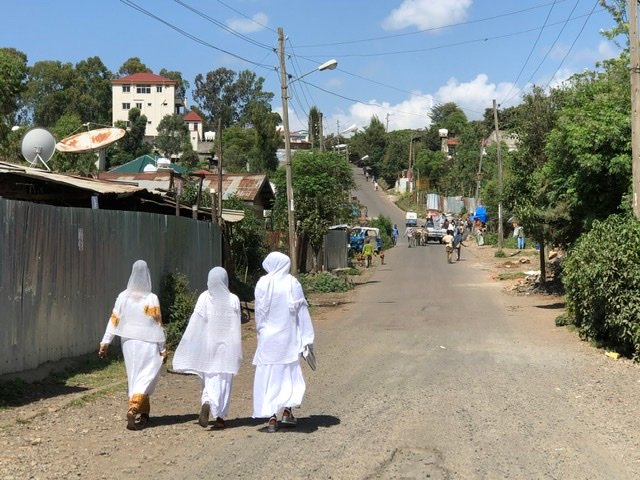
Street scene, Gondar. Three ladies walk back from a visit to church.
A young boy stares at us curiously. Also, typical Ethiopian homes
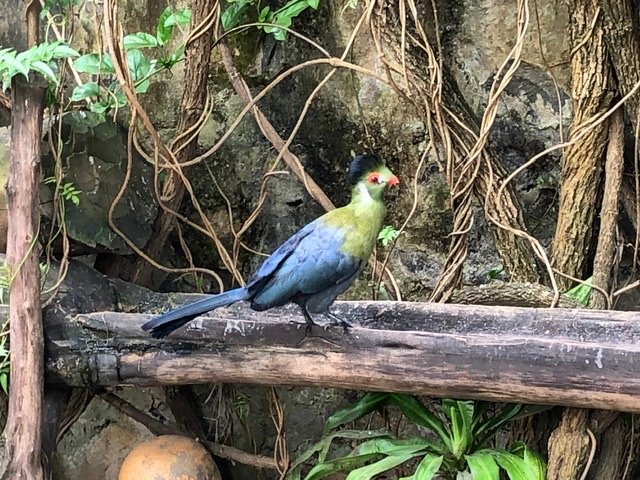
A Ruspoli’s Turaco, an endemic bird to Ethiopia that flew into a restaurant we were dining in. So amazing! This bird was once the most sought after and elusive of Ethiopia’s birds… first discovered in 1893 by Prince Ruspoli of Italy he was trampled to death by elephants before divulging where he had found the beautiful bird. The next Ruspoli Turaco wasn’t found until the 1940’s. Then 30 more years passed before the next sighting. Today there are thought to be just 10,000 left… and we amazing had one fly into our restaurant!

Enjoying people watching in the piazza, town square. And yes, piazza. As in Italian, piazza. Ethiopia was never colonized by a European power, but when the Europeans scrambled to snatch up and take Africa for themselves in the late 1800’s Italy belatedly tried their best to occupy what they could of the Horn of Africa countries of Ethiopia, Eritrea, and Somalia from 1936-1944. The Ethiopian Kingdom successfully mounted an armed rebellion to their Italian invaders and drove them out. Today, not only does this make Ethiopia the only non-colonized African nation but they also have a few more positive Italian remnants including their piazzas, some stucco buildings, and omnipresent pizzas and pastas (which was a nice balance to our heavy Ethiopian dishes.)
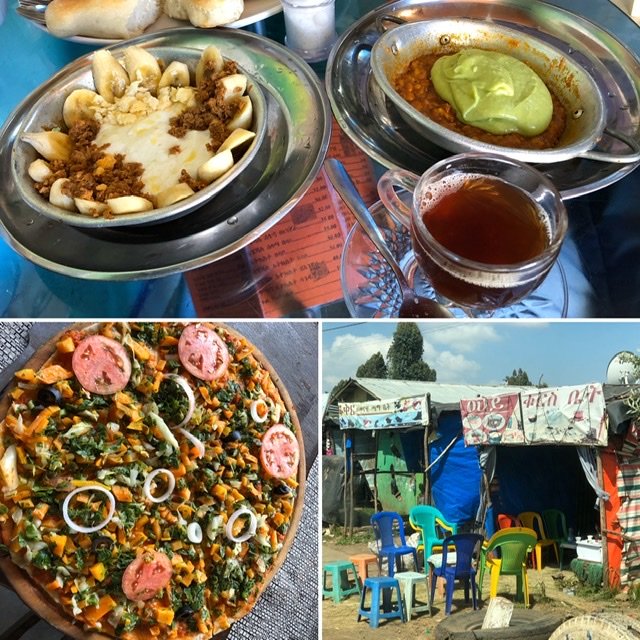
Speaking of pizza, a typical Ethiopian rendition in the bottom left corner. You’ll notice something pivotal missing. Ah yes, the goopy cheese. The lack of dependable refrigeration makes dairy hard to come by here. The Italians unfortunately did not leave thier cheese making skills behind. Argh. Yes, also missing yogurt, milk and creamy cheesy goodness.
That said, we may be lacking in dairy, but avocados are back en force ?. At top, a typical Ethiopian breakfast called a “Ful.” On the right, bean purée with avocado and at left the more rare, “modern ful” which features yogurt(!), bananas and puréed chickpeas. Tea is delightful, made from cinnamon and cloves.
Bottom right is a typical Ethiopian restaurant or food stall.

Gondar has two historic sites which commonly bring travelers to it. The first is Debre Berhan Selassie Church, built in 1693, which is said by some to be the most beautiful of the Ethiopian churches. (Although we’re scratching our heads over this claim after seeing the churches in Lalibela.)

Having grown up in a land where Christ’s image has always been portrayed as a pale blue-eyed brunette, it was startling yet endearing to see Him depicted and all the religious motifs painted in the church frescoes as decidedly more African with darker skins, eyes, and hair that could easily be mistaken as an Afro. Above, the ceiling of 80 African cherubic faces with the most adorable little Afros. An image is of St. George slaying the dragon, is pictured first. According to folklore, he rescued a princess who was about to become dinner for a dragon that had settled near the city of Silene – allegedly in modern-day Libya. Today, St. George is one of Ethiopia’s most worshipped saints who even has a national beer named in his honor.

Ethiopia has close ties with all three major Abrahamic religions, and it was the second in the world (after Armenia) to officially adopt Christianity in the 4th century as its state religion. Today, Christians account for 63% of the country’s population. Christ’s image depicted in the Debre Berhan Selassie, along with the Holy Trinity.
The painted images in the church walls portray images of the Old Testament on one wall and the New Testament on another. The illustrated stories were magnificently crafted works of art unlike any we’d ever seen before. This one, of course representing the aftermath of the crucifixion, followed by the resurrection.
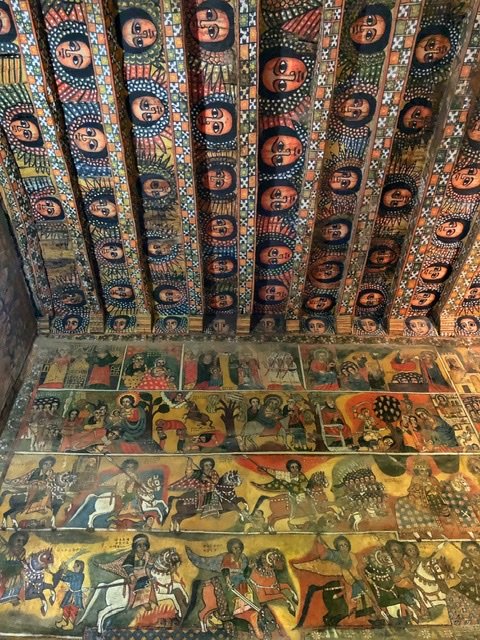
That’s a lot of little angel faces!
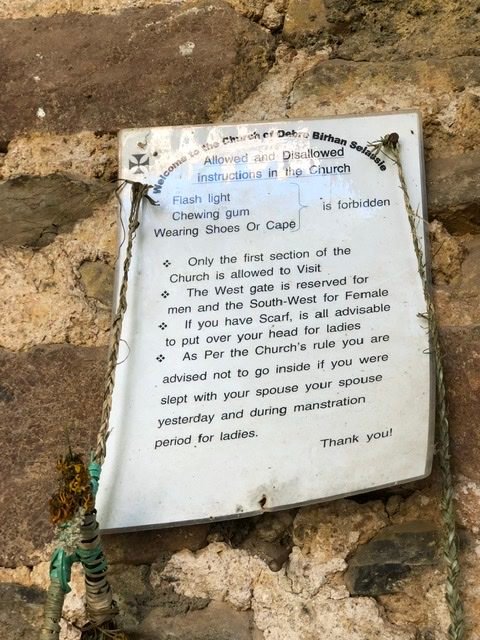
For the record, these are the rules listed for entering the church. Hmmm. How are they going to conduct a search for item number four?
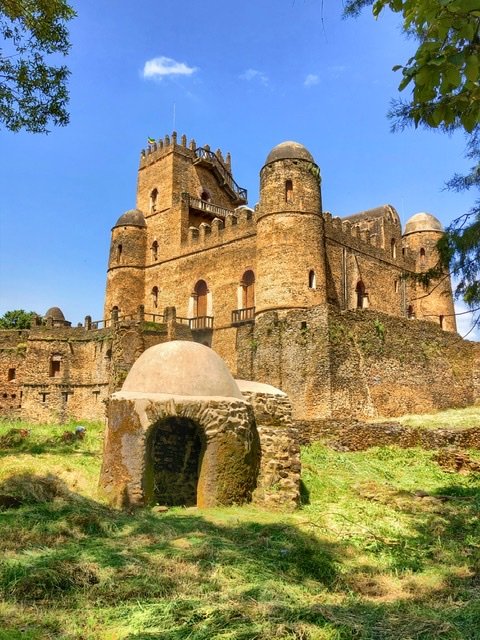
Secondly, the 17th century Fasil Ghebbi Royal Enclosure is one of that places that make you ask… “whoa, am I really in Africa?!” Indeed, African castles are not a common site. This compound was built by the Ethiopian Emperor Fasilida in the mid-1600’s and was inscribed as UNESCO in 1979. It housed multiple emperors through the years, but each one kept adding on to the complex because clearly the work of the guy before wasn’t good enough.
Fasil Ghebbi is a cornerstone that gives Gondar much of its character. The three-story castle of Fasiliada was made from wood, stone and limestone and it’s unique architecture is a blend of Portuguese, Axumite, and even Indian influences. In the foreground is a three-room sauna built at a later night by another prosperous emperor called Iyasu.
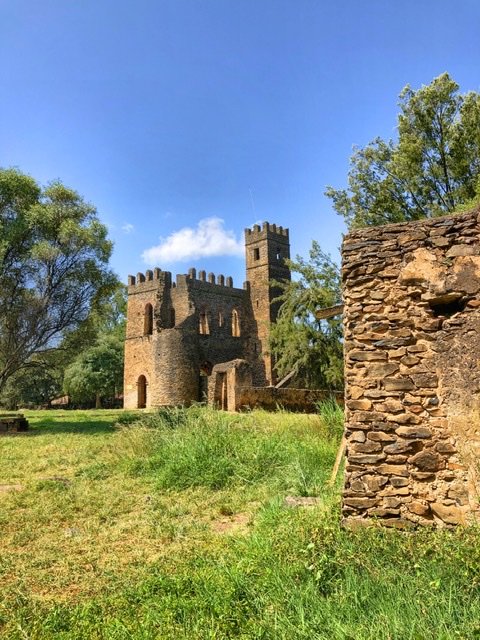
This building, an archive, was built by Emperor Yohanne’s, Fasilida’s nerdy, bookish son and successor.
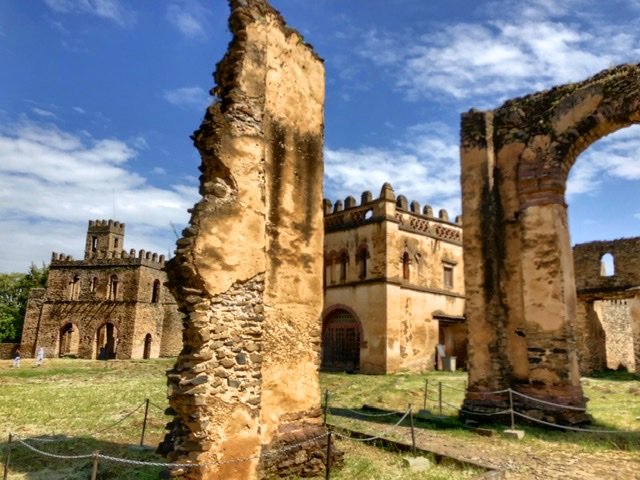
Another view of the archive, as well as the handsome facade of Yohannes’ library where he avoided contact with people by keeping his nose in his 17th century version of a smartphone.

Mandy takes it in, wishing she had a 17th century smartphone. She only has a kindle these days.
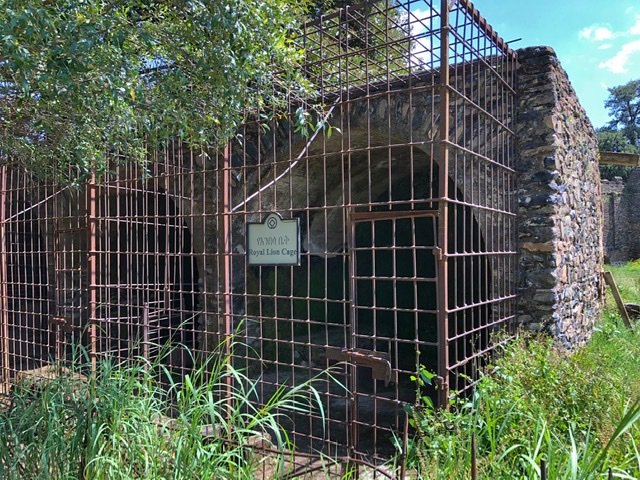
The absurdly minute Lion’s Cage is also on-site at Fasil Ghebbi. It was built around 1716 (not sure if these are regular or Ethiopian dates, by the way), by Dawit III and was reputedly still used until 1992 when the last lion died ?
Through the Simien Mountains
If we hadn’t already earned our backpacker street cred, we believe we earned it on the ride from Gondar to Aksum. A harrowing, ten-hour ride on a decades old local bus through northern Ethiopia’s Simien Mountains shook our bones and tenderized our bodies as we traveled down a gravel road hugging the edge of seriously hair-raising cliff. It made the legroom on European budget airlines appear to be an actual holiday as the knocking produced knee bruises from the seat in front of us. It was complemented by blaring Ethiopian pop out of tinny speakers, zero bathroom or food breaks, and more than half a dozen police checkpoints, most of which as the only foreigners, we were given the respectful nod, but at least once where we were searched alongside the locals. (Which actually seemed more fair.) Ethiopia definitely tested our patience, endurance, and nerves, but the emerald natural splendor, witnessing strikingly different lifestyles, flavor-explosions of complex food and big smiles from locals are certainly making our time fruitful. Not all travel is meant to be easy. But getting out of your comfort zone is where the real learning begins.
Aksum
If we had to put down roots somewhere in Ethiopia, it would probably be Aksum, where we spent five nights at the lovely Delina Hotel ($20/night). Aksum was the most comfortable, chill, easy to get around, and most welcoming little town we experienced in Ethiopia. Aksum is in northern Ethiopia, only 30 miles from the Eritrean border, and is arguably the Christian heartbeat of Ethiopia.
Why? Aksum is reputedly the last resting place of the Ark of the Covenant, as well being the final resting place of King Bazen (one of the three kings to visit Christ at His birth), and… if that weren’t enough, it’s also the home of legendary Queen of Sheba.
However, in addition to all this, it’s also just a nice, pleasant place to be. The town has a easy-to-follow grid layout, clean cobbled well-lit streets, bright colorful buildings, and relatively few tourists (which blessedly means few aggressive touts to avoid.)
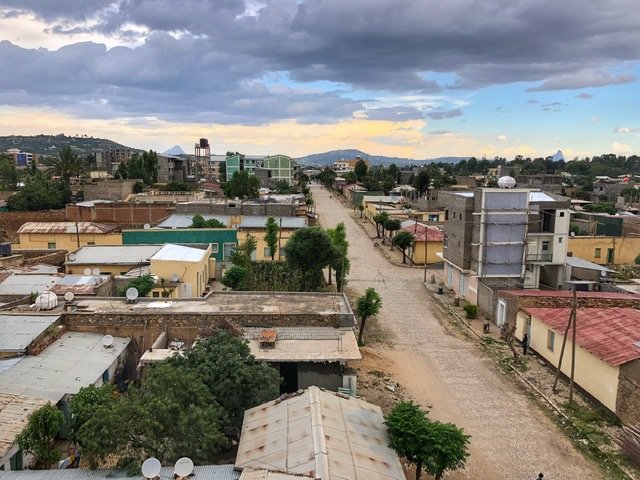
The view from the roof of our hotel. You can see the eye catching mountain peaks jutting up dramatically in the background. The staff of the Delina Hotel had us make ourselves right at home here, hanging our laundry on the roof, along with all the sheets. Every morning it was bright and sunny, and by afternoon it greyed over. The temperatures the whole time we were in Axum over 5 days were 25C high – 11C low (78F – 51F)… every single day! In other words, perfect!
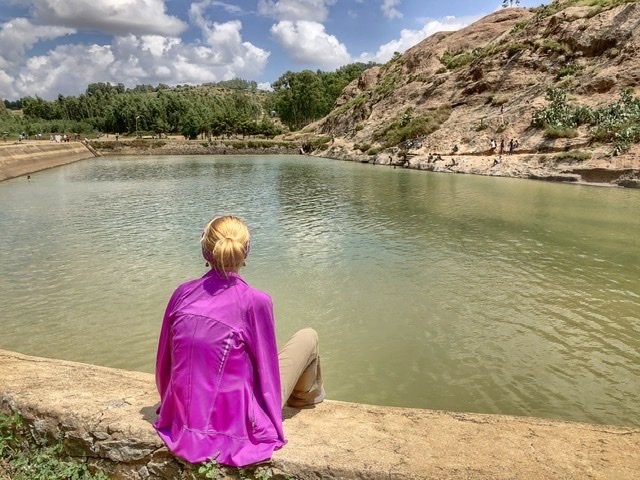
Taking a moment to soak in (eyes only this time) the Queen of Sheba bath, which is an ancient reservoir which has existed since at least the Axumite Empire (more about this later.) However, despite the legends, and its namesake, it’s most likely not where Queen of Sheba came to bathe. More likely, it was a royal water reservoir… Aksum was known to have high quality drinking water in antiquity. Disappointedly, the pool doesn’t show its age as the outer portion of the bowl was coated with concrete in the 1960s, making it look more like a modern trough than an ancient relic. Kids today seem to enjoy it as a local swimming hole.

Oh we had a lot of these mouth watering treats in Ethiopia…avocado smoothies ? surprisingly tastes much, much better than you would imagine. And for just $1!
Pleasant streets of the Aksum Old Quarter. Especially enjoyable at sunset.

It looked like quite a construction boom going on in this part of the country. Check out the scaffolding, made incredibly out of wood and sticks. Pretty sure that wouldn’t pass any safety standards whatsoever in the States… but this is what they use all over Ethiopia! Sometimes above 15 stories!
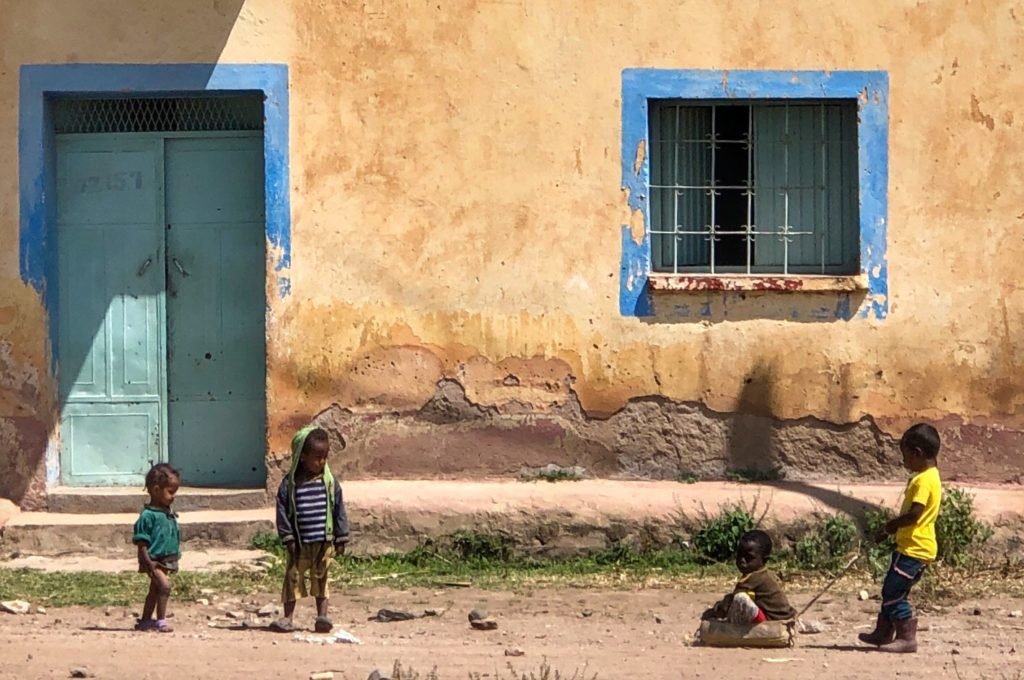
Kids playing in the streets

Also in the streets…goats. Everywhere. Many of them seemingly without owners and just wondering aimlessly around town.

Two fascinating trees… the first, a prickly cactus tree and the second, a poinsettia tree. Had no idea where those prevalent little Christmas flowers came from!

The staff was very familiar with us by the time we left at this restaurant. Our breakfast spot for five mornings in a row (a record for us!) where we enjoyed $2 breakfasts, including coffee, and view on the balcony. A couple interesting things we observed was a lowly white horse who seemed very out of his element as he wondered about town, with no owner, for days. Also, men hold hands in Ethiopia. This affectionate symbol of heterosexual brotherhood and friendship is incredibly common throughout Ethiopia. Of course, if this was an illegal homosexual act of affection, well, then, these men could sadly be thrown in jail. ?
The Religious and Cultural Sites of Aksum
The Aksumite Empire, which was centered in northern Ethiopia, Eritrea, and much of Yemen, was one of the biggest empires of the ancient world (100-940AD), and certainly the largest of Sub-Saharan Africa. Never heard of the Axumites? We were shocked to learn that this once great and sophisticated empire, which seems to have been omitted from our collective world history curriculums, had in fact, established a trading and political empire that stretched from the Sudanese Nile across the Red Sea to Southern Arabia and even went all the way to Italy as well as India.
While you may not have heard of the Axumites, you’ve likely heard of at least some of thier legendary contributions to the ancient world including the Ark of the Covenant, the Queen of Sheba, (the tomb of) King Bazen (one of the Kings from Christ’s birth), and the mysterious obelisks of Axum.
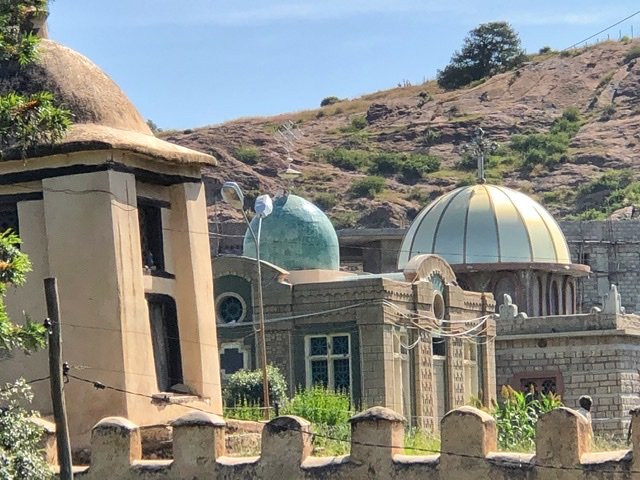
Surprisingly, Axum also marked the second stop on our Indiana Jones tour ‘o the world. In a nondescript church (middle), inside one of the most sacred places of the Christian Orthodoxy in Ethiopia, allegedly lies the final resting place of one of the holiest of holies, the Ark of the Covenant. (Aka, the gold-plated wooden chest with the stone tablets Moses received from God with the 10 Commandments on them.)
If you didn’t know otherwise, this 4th Century church —the Cathedral of Maryam Tsion— is probably something you’d pass by without a second glance. In fact, only two westerners claim to have ever had the privilege of “seeing” the ark, and that was in the 18th and 19th centuries. And never verified. This said, only one person alive has seen this relic…a full time monk who is the only person alive assigned to guard the relic as a lifetime appointment. And don’t think you can try to sneak a peak at the supposed Ark either, some years ago a couple of tourists tried to storm the building, jumping the protective fence to catch a glimpse and… bam! They were promptly taken down, arrested, and detained by law enforcement.
So how did the Ark supposedly get to Axum in Ethiopia? The short end of the legend is that, In the Old Testament, the Ark was housed at King Solomon’s Great Temple in Jerusalem. After the sacking of the Great Temple in 587 BC, the Bible falls silent as to the Ark’s specific whereabouts. Some say it was hidden in a secret chamber in Jerusalem and others claim it was destroyed.
According to Ethiopian legend however, along with some religious scholars, the Ark was actually brought to Ethiopia around the 1st Millennium BC by supposed Axumite son of King Solomon and Queen of Sheba, King Menelik after he had visited Jerusalem to visit with his father.
Whether or not the Ark was in there, or not…we cannot confirm nothing deny. We didn’t get much closer than a few hundred feet unfortunately. After all, We vividly remember what happened on Indiana Jones to that guy who glimpsed the Ark…and got his face promptly melted off.

Aksum’s most iconic “viewable” monument is a field of 120 stelae, which range from small stones to 10-story single stone obelisks. It would seem this includes the three tallest obelisks of ancient times, and were (probably) erected around 2nd-4th Centuries AD. Unfortunately, thorough archeological research of the Axumite kingdom is severely lacking. The last major excavation was done in 1959, and there continues to be A LOT of speculation surrounding their history and society.
The obelisks are said to have an apparent (yet unknown) religious significance, since most of them have a crypt buried beneath them…almost as though this were an ancient cemetery with some seriously grandiose headstones. Including, and amazingly, an adequate explanation for either the true purpose of, or how these massive single blocks of granite blocks (some weighing more than 500 tons!) were transported and erected. Although some Ethiopians believe it was from the supernatural powers of the Ark of the Covenant. A more (probable) theory has it that the use of elephants and pulleys were used. Whichever the case, it’s a truly remarkable feat of engineering to have achieved 2000 years ago.

The practice of erecting funerary stelae seemed to die out (pun intended) following the adoption of Christianity. Remhai Stele, was the largest ever erected in Aksum and would weigh 523 tons and stand 33 meters (108’) if still standing. Scholarly opinion is that it (probably) wasn’t upright for very long, if ever, because the podium and base is too small to support it. What a colossal…miscalculation. Probably career ending, one way or another.
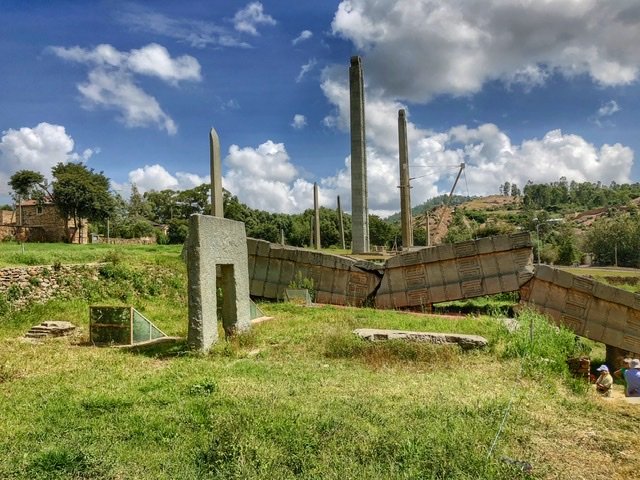
A collection of the stelaes, including the toppled behemoth in the foreground. The ornamentation of the obelisks is very intriguing and odd… most have carved doors (including handle hardware) at the base, then as you look up framed windows ascend up the stelae in an even story like patten up to the top, where a gold or brass emblem was placed at the apex. It makes them rather eerily resemble skyscrapers or possibly even lighthouses. Where could they possibly have come up with this type of design?!

Another less grand, yet somewhat more ancient, large stelae field is located on the outskirts of Axum town. The very curious thing is that this historic stelae field, blanketed in 1800+ year-old ancient artifacts…is literally somebodies farmland, where crops are planted, tilled and harvested, all beneath these incredible artifacts of a lost and still mysterious civilization. It’s awkward sightseeing, but completely available for any Joe Schmo to trample through, or worse. Anytime.

In Axum, it’s bewildering to think of the archeological wonders laying-in-wait and still uncovered in an around Aksum that would probably make Indiana Jones cry, “this should be in a museum!!”

Underneath some of the stelae, a world of underground tunnels and tombs awaits. Most tombs and tunnels under the stelae, by-the-way, have yet to be excavated.
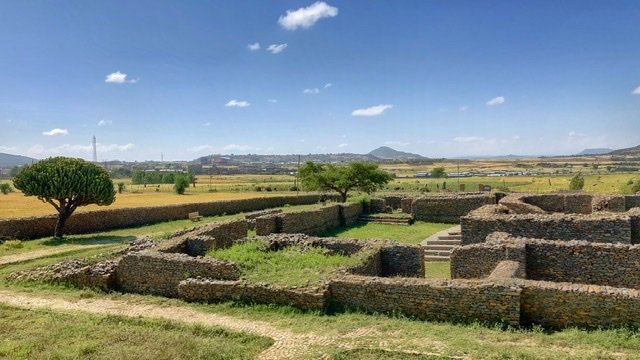
This is the remains of Dongar Palace, or what is claimed to be Queen of Sheba’s palace. However, it’s quite unlikely she actually lived in this structure, considering that it was likely built in 7th century AD, well after her time. More likely is that this palace was built on top of and incorporated an earlier palace, that was hers. You can see why there’s a wee bit of speculation about everything here. And, Exactly why those archeological experts could be employed for a lifetime here…can someone please call Josh Gates at “Expedition Unknown”?!
The Tomb and crypt of King Bazen, or Balthazar, better known as one of the three kings who presented gifts to Baby Jesus and who also announced the news of His birth to the people of Ethiopia. Incidentally, myrrh and frankincense, were readily available, traded and prized possessions of the Axumite Empire. P.S. if you look closely, you can still see his feet hanging around ?
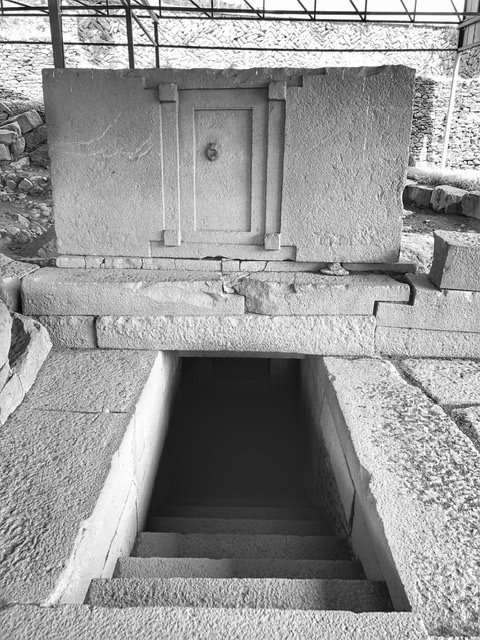
A different stelae tomb, the Tomb of the False Door from the 4th century. It’s thought to have held “objects of great value” but was likely looted long ago.
Following Aksum, we got the luxury of being awake for the better part of 48-hours straight because the screeching, nails-on-a-blackboard Ethiopian music from a traditional three-day(!!) Ethiopian wedding and accompanying bass were incessantly thumping our guesthouse. So, we had to share a taste of this music…which can be fun for the first 30 minutes. ? (Note, this is significantly better than the wedding music.)
And for those of you who were concerned about our safety in Ethiopia, please note that mocking these dance moves was probably the most dangerous thing we encountered….
Ethiopia Wrap-Up
Time Spent: 23 Days
Money Spent: $895.06 or $55.95/day (16 days, not including treks)
Budget Travel Meter*: $$$ (not including treks)
The upsides of Ethiopia
- A culture unlike any we’ve ever experienced. Everything feels new, exotic, fascinating, and really off-the-beaten-path.
- The food…OMG…the food
- The nature is variable and breathtaking
- Ruins and religious history galore
- People don’t often have a lot here, but they’re some of the most friendly, smiling people we’ve encountered
- Access to some of the best coffee we’ve ever had
- Avocado smoothies for $1
- It can be very budget-friendly if you’re willing to rough it a little. Or, if you’re willing to spend a bit, you would probably experience a very different side than us.
- The TESFA Trekking program. We really enjoyed our treks and getting to walk with the purpose of giving back to communities.
- Seemingly eternal spring temperatures and lots of sunshine
The downsides of Ethiopia
- It’s definitely the most challenging destination we’ve been to in terms of ease of transportation, human behavior, and living without always having modern conveniences. Blackouts are regular, as is losing water supply, not having hot water, and of course, unreliable internet.
- The high cost of the visa ($50/each) + Lalibela Churches (also $50/each)
- Outside of the capital, it’s difficult to find food that’s not Ethiopian, or pasta/pizza
- The music. OMG…it’s incessant and certainly an acquired taste
- Using the Ethiopian Birr is difficult because the highest bill is valued at $3.38. This means you’re constantly carrying around a very large brick of cash.
Would we go back? Doubtful, although Ethiopia is huge country with a lot to offer the traveler and there’s a lot we didn’t explore including the southern tribal regions. We also have a definite interest in seeing neighboring Djibouti.
Budget Travel Meter* The Budget Meter gauges how hard it was for us to stick to our $50/day budget. We’re factoring our Budget Meter by our daily food consumption options.
- $ – Eating-out up to twice a day and ordering whatever the hell we want, with dessert!
- $$—Eating-out once a day in a restaurant of our choice
- $$$—Eating-out once a day, on cheap pizza or local street food meals, usually involving copious amounts of filling bread
- $$$$—Eating-in every meal, healthy/fresh & in-season produce options
- $$$$$—Eating powdered soup & potatoes for every meal.

